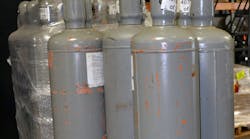Flammable refrigerant alternatives are becoming increasingly viable as global environmental regulations push the HVACR industry toward low-GWP refrigerants. Naturally occurring hydrocarbons (HC) such as propane (R-290) and a new class of hydrofluoroolefin (HFO) refrigerant blends are among the most likely flammable refrigerants to be considered as replacements.
Since these low-GWP options have varying degrees of flammability, they’re subject to requisite standards to ensure safe operating and handling protocols.
In the current industry landscape, there are a number of organizations that have developed codes and standards to manage the safe use of flammable refrigerants. Since the majority of today’s safety standards were developed prior to the increased emphasis on green refrigerant alternatives, many are now currently under revision to include A2L and A3 refrigerants with the intent to evaluate their potential use with modern equipment, applications and system architectures.
When dealing with flammable refrigerants, the following criteria are evaluated to ensure safe use:
• The lower flammable limit of the refrigerant
• Amount of charge in equipment
• Risk of refrigerant leak
• Area where a leaked refrigerant could occur
• Presence of ignition sources
While we can’t predict the extent of the code changes, we can report on the most relevant safety standards currently under revision:
• ASHRAE Standard 34
In the U.S., ASHRAE Standard 34 defines the flammability and toxicity classification of refrigerants, with the letters A and B designating lower and higher toxicity, and the numbers 1, 2 and 3 denoting the level of flammability from none, lower and higher flammability, respectively. For example, R-290 is classified as A3, meaning it has lower toxicity and higher flammability. This standard was recently updated to include the flammability subclass of 2L for refrigerants that burn slower than those designated as Class 2. Newer HFO blends, such as R-1234yf, fall into this A2L classification.
In the U.S., ASHRAE Standard 34 defines the flammability and toxicity classification of refrigerants, with the letters A and B designating lower and higher toxicity, and the numbers 1, 2 and 3 denoting the level of flammability from none, lower and higher flammability, respectively.
• ASHRAE Standard 15
ASHRAE Standard 15 is the U.S. safety standard for refrigeration system design, construction, installation and operation. It adopts the classifications set forth in ASHRAE 34, and is under revision in part due to the inclusion of the A2L classification. The current standard also prohibits the use of A3 and B3 refrigerants except where approved by the authority having jurisdiction (AHJ). Once Standard 15 is revised, ASHRAE will propose revising the building model codes in the U.S.
ASHRAE Standard 15 is the U.S. safety standard for refrigeration system design, construction, installation and operation. Once Standard 15 is revised, ASHRAE will propose revising the building model codes in the U.S.
• UL Standards
UL 1995 is the most recent Underwriters Laboratory (UL) listing pertaining to HVACR; it does not address flammable refrigerants. However, it is being revised in accordance with the international standard, IEC 60335-2-40, which is currently under revision to include the introduction of A2Ls.
• International Standards
The International Electrotechnical Commission (IEC) is in the process of revising its codes that affect heating and cooling equipment, commercial refrigeration appliances, and ice and ice cream machines, including: IEC 60335-2-89 and IEC 60335-2-24. It’s widely anticipated that the standards around charge limits — for both A3 and A2L refrigerants — will be included in the IEC’s revisions.
The International Electrotechnical Commission (IEC) is in the process of revising its codes that affect heating and cooling equipment, commercial refrigeration appliances, and ice and ice cream machines.
As is the case with the UL adoption of an existing IEC standard, the international standards are often the benchmark from which global safety standards are implemented. The U.S. is no exception to this rule, although usually with a degree of deviation from the IEC standards. It’s also as important to keep in mind that until national safety standards are both adopted and accepted in the U.S., A2L and A3 applications may be subject to AHJ.
While exact timing on regulatory matters is difficult to predict, we expect some movement in these areas through 2017 due to the urgency of HC and HFO adoption.
CLICK HERE FOR EPA REFERENCE MATERIAL










